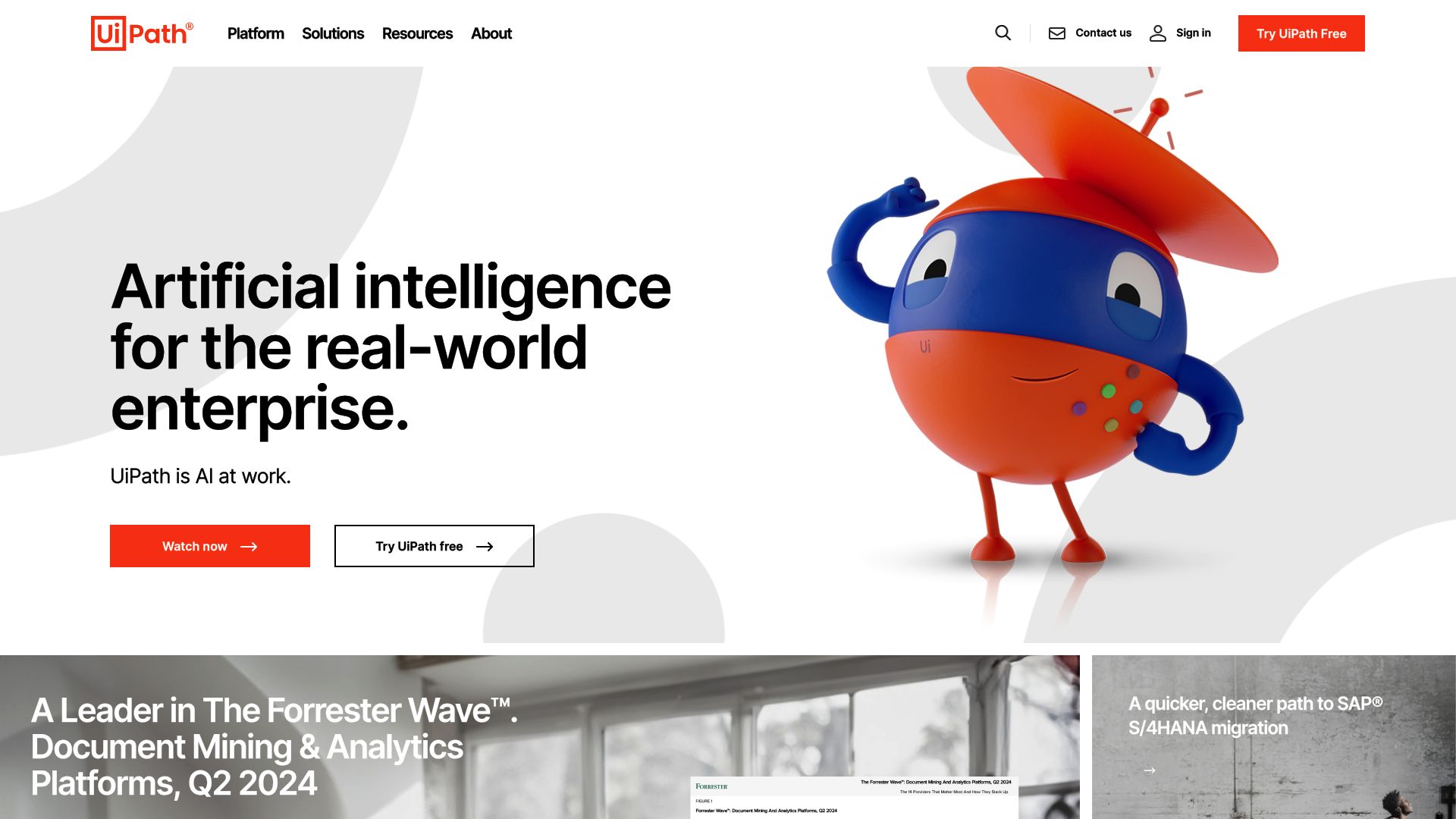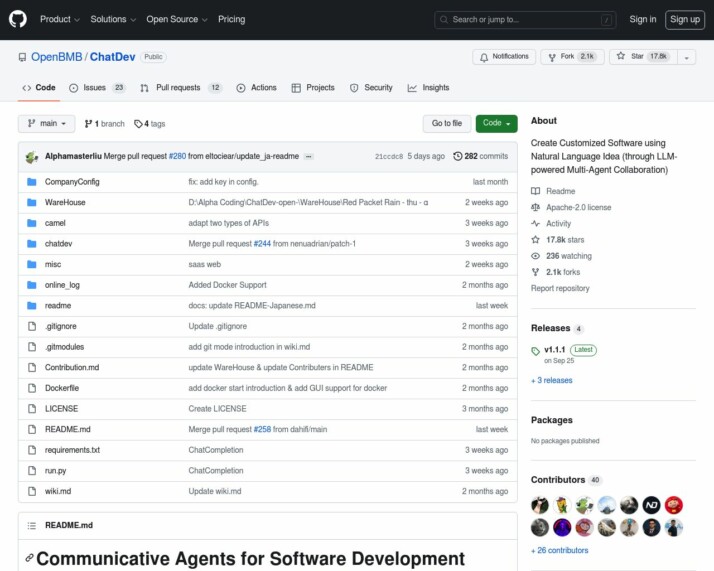UiPath vs. ChatDev: Comparing AI Automation Platforms
The AI landscape evolves rapidly, and businesses seek powerful tools to harness its potential. This comparison explores UiPath’s enterprise-grade RPA platform, ChatDev’s AI-driven software development framework, and SmythOS’s versatile agent creation system. We’ll examine how each platform approaches automation, development, and AI integration, highlighting their strengths, limitations, and ideal use cases. By the end, you’ll understand which solution best fits your organization’s needs, whether you’re streamlining business processes, prototyping software ideas, or building sophisticated AI agents for diverse applications. Discover how these platforms can transform your approach to automation and AI development, potentially reshaping your business operations and innovation strategies.
UiPath Overview
UiPath revolutionizes enterprise automation with its comprehensive platform. The company’s flagship product, UiPath Enterprise RPA Platform, empowers organizations to automate repetitive tasks and complex business processes. This solution caters to a wide range of industries, from finance and healthcare to manufacturing and retail, enabling businesses to boost productivity and reduce operational costs.
UiPath revolutionizes enterprise automation with its comprehensive platform… empowers organizations to automate repetitive tasks and complex business processes.
UiPath offers a suite of tools designed to streamline the entire automation lifecycle. At its core, UiPath Studio provides a visual development environment where users can create automation workflows using drag-and-drop functionality. This intuitive interface allows both seasoned developers and business users to build sophisticated automations without extensive coding knowledge.


UiPath Orchestrator serves as the control center for deploying and managing automation at scale. It enables centralized management of robotic processes, ensuring secure and efficient execution across the enterprise. The platform’s AI capabilities, integrated through UiPath AI Center, allow organizations to incorporate machine learning models into their automation workflows, enhancing decision-making and processing capabilities.
While UiPath excels in many areas, it faces challenges in certain aspects. The platform’s enterprise focus may make it less accessible for smaller organizations or individual developers. Additionally, the learning curve for advanced features can be steep, potentially requiring significant training investment. UiPath’s pricing model, while flexible, can become complex for large-scale deployments, necessitating careful cost management.
In the competitive landscape of RPA and intelligent automation, UiPath stands out for its robust enterprise features and extensive partner ecosystem. The platform’s strengths lie in its scalability, comprehensive integration capabilities, and continuous innovation in AI-driven automation. However, organizations must weigh these advantages against their specific needs, resources, and long-term automation strategy to determine if UiPath aligns with their goals.
ChatDev Overview
ChatDev revolutionizes software development by automating the entire process using large language models (LLMs). This open-source framework simulates a virtual software company where AI agents collaborate to design, code, test, and document software projects.
The platform leverages a team of specialized AI agents, each fulfilling roles like CEO, CTO, programmer, and tester. These agents communicate through a structured chat chain, breaking complex development tasks into manageable steps. ChatDev’s ability to generate complete software applications in minutes at minimal cost sets it apart from traditional development methods.
ChatDev revolutionizes software development by automating the entire process using large language models (LLMs). This open-source framework simulates a virtual software company where AI agents collaborate to design, code, test, and document software projects.
ChatDev excels in rapid prototyping and idea validation, making it ideal for startups, researchers, and developers seeking to quickly bring concepts to life. The system supports the full software development lifecycle, from initial design to final product delivery, including source code, user manuals, and environmental dependencies.


Key features of ChatDev include its replay functionality, allowing users to review the entire development process through a web app. This transparency enhances understanding and trust in the AI-driven development approach. The framework also integrates with Git for version control, enabling collaborative and iterative development practices.
While ChatDev offers impressive automation capabilities, it may face challenges in handling highly complex or specialized software projects that require deep domain expertise. Additionally, the quality and reliability of the generated code may vary, potentially requiring human oversight and refinement for production-grade applications.
ChatDev’s vision to democratize software development through AI automation positions it as a transformative tool in the tech industry. By significantly reducing development time and costs, it opens new possibilities for innovation and experimentation in software creation.
Feature Comparison
UiPath and ChatDev offer distinct approaches to automation and software development, with notable feature gaps between them. UiPath excels in robotic process automation (RPA) with enterprise-grade capabilities, while ChatDev focuses on AI-driven software development using large language models.
In core components, UiPath provides a comprehensive RPA platform with visual development tools, orchestration, and AI integration. Its Studio and StudioX environments enable both developers and business users to create automation workflows. However, UiPath lacks native support for autonomous agents or multimodal inputs, which limits its adaptability in more complex AI scenarios.
ChatDev, on the other hand, simulates an entire software development process using AI agents. It excels in rapid prototyping and idea validation but may struggle with enterprise-scale deployments or highly specialized projects. Unlike UiPath, ChatDev does not offer traditional RPA capabilities or extensive integration with business systems.
Regarding security features, UiPath maintains a strong focus on enterprise-grade security with robust data encryption, OAuth support, and IP control mechanisms. ChatDev, being an open-source framework, may not inherently provide the same level of security features, potentially requiring additional measures for enterprise use. This gap in security capabilities could be a significant consideration for organizations dealing with sensitive data or stringent compliance requirements.
Feature Comparison Table
| UiPath | ChatDev | SmythOS | |
|---|---|---|---|
| CORE FEATURES | |||
| AI Agents | ❌ | ✅ | ✅ |
| Hosted Agents (Dev, Production) | ❌ | ✅ | ✅ |
| Visual Builder | ✅ | ❌ | ✅ |
| No-Code Options | ❌ | ❌ | ✅ |
| Memory & Context | ❌ | ✅ | ✅ |
| Autonomous Agents | ❌ | ✅ | ✅ |
| Explainability & Transparency | ❌ | ✅ | ✅ |
| Multimodal | ❌ | ✅ | ✅ |
| Problem-Solving Capabilities | ❌ | ✅ | ✅ |
| Multi-Agent Collaboration | ❌ | ✅ | ✅ |
| Work as Team | ❌ | ✅ | ✅ |
| Bulk Work | ✅ | ❌ | ✅ |
| Agent Work Scheduler | ✅ | ❌ | ✅ |
| SECURITY | |||
| Constrained Alignment | ❌ | ❌ | ✅ |
| IP Control | ✅ | ❌ | ✅ |
| COMPONENTS | |||
| Foundation AIs | ❌ | ✅ | ✅ |
| Huggingface AIs | ❌ | ✅ | ✅ |
| Zapier APIs | ❌ | ✅ | ✅ |
| Classifiers | ❌ | ✅ | ✅ |
| Data Lakes | ❌ | ❌ | ✅ |
| DEPLOYMENT OPTIONS (EMBODIMENTS) | |||
| Deploy as API | ❌ | ✅ | ✅ |
| Deploy as Webhook | ❌ | ✅ | ✅ |
| Staging Domains | ❌ | ❌ | ✅ |
| Production Domains | ❌ | ❌ | ✅ |
| Deploy as Site Chat | ❌ | ✅ | ✅ |
| Deploy as Scheduled Agent | ❌ | ❌ | ✅ |
| Deploy as GPT | ❌ | ✅ | ✅ |
| Scalability | ✅ | ❌ | ✅ |
| DATA LAKE SUPPORT | |||
| Hosted Vector Database | ❌ | ❌ | ✅ |
| Sitemap Crawler | ❌ | ❌ | ✅ |
| YouTube Transcript Crawler | ❌ | ❌ | ✅ |
| URL Crawler | ❌ | ✅ | ✅ |
| TXT File Support | ❌ | ❌ | ✅ |
Best Alternative to UiPath and ChatDev
SmythOS stands out as the superior alternative to UiPath and ChatDev for AI automation. Our platform combines the best of both worlds, offering enterprise-grade capabilities with cutting-edge AI agent technology.
Unlike UiPath’s focus on traditional RPA, SmythOS provides a comprehensive ecosystem for creating and deploying intelligent AI agents. Our intuitive drag-and-drop interface allows users to build complex AI workflows without extensive coding knowledge, democratizing AI development across organizations.
SmythOS provides a comprehensive ecosystem for creating and deploying intelligent AI agents. Our intuitive drag-and-drop interface allows users to build complex AI workflows without extensive coding knowledge
While ChatDev simulates software development using AI, SmythOS takes a more versatile approach. We enable the creation of AI agents for a wide range of use cases beyond just software development. From customer service chatbots to data analysis tools, SmythOS adapts to your specific needs.
SmythOS excels in areas where UiPath and ChatDev fall short. Our platform offers robust multimodal capabilities, allowing agents to process and respond to various input types. We also provide advanced features like autonomous agent collaboration and problem-solving capabilities, pushing the boundaries of what’s possible with AI automation.
Security and scalability set SmythOS apart. Unlike ChatDev’s open-source framework, we offer enterprise-grade security features, including data encryption and OAuth support. Our platform scales seamlessly to meet the demands of growing businesses, ensuring your AI solutions remain effective as your needs evolve.
Conclusion
UiPath, ChatDev, and SmythOS each bring unique strengths to the automation and AI development landscape. UiPath excels in enterprise-grade RPA, offering robust tools for automating business processes at scale. ChatDev innovates in AI-driven software development, simulating an entire development team using language models. However, SmythOS emerges as the superior choice for businesses seeking a comprehensive, flexible, and user-friendly AI agent development platform.
SmythOS stands out with its intuitive drag-and-drop interface, extensive integration ecosystem, and versatile deployment options. Unlike UiPath’s focus on structured workflows or ChatDev’s emphasis on code generation, SmythOS empowers users to create sophisticated AI agents that can handle a wide range of tasks, from data analysis to customer interactions. The platform’s support for multimodal inputs, problem-solving capabilities, and seamless collaboration between multiple agents puts it a step ahead in adaptability and functionality.
While UiPath and ChatDev serve specific niches effectively, SmythOS offers a more holistic solution for businesses looking to leverage AI across various applications. Its ability to deploy agents as APIs, chatbots, or scheduled tasks, combined with robust security features and scalability, makes it an ideal choice for organizations of all sizes. SmythOS not only simplifies the AI development process but also opens up new possibilities for innovation and efficiency improvements.
To experience the transformative power of SmythOS for yourself, explore our diverse range of AI-powered agent templates. These templates offer a quick start to building custom AI solutions tailored to your business needs. For those ready to dive in, you can create a free SmythOS account and start building AI agents with no time limit or risk. Discover how SmythOS can revolutionize your approach to AI integration and automation, driving your business forward in the age of intelligent technologies.
Last updated:
Disclaimer: The information presented in this article is for general informational purposes only and is provided as is. While we strive to keep the content up-to-date and accurate, we make no representations or warranties of any kind, express or implied, about the completeness, accuracy, reliability, suitability, or availability of the information contained in this article.
Any reliance you place on such information is strictly at your own risk. We reserve the right to make additions, deletions, or modifications to the contents of this article at any time without prior notice.
In no event will we be liable for any loss or damage including without limitation, indirect or consequential loss or damage, or any loss or damage whatsoever arising from loss of data, profits, or any other loss not specified herein arising out of, or in connection with, the use of this article.
Despite our best efforts, this article may contain oversights, errors, or omissions. If you notice any inaccuracies or have concerns about the content, please report them through our content feedback form. Your input helps us maintain the quality and reliability of our information.
